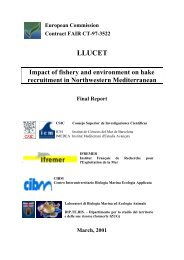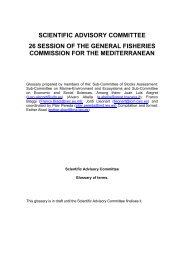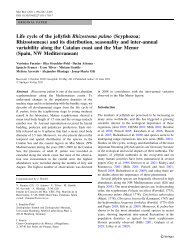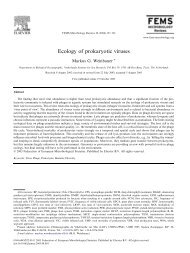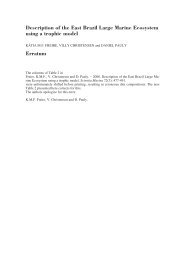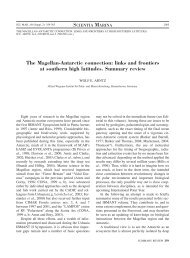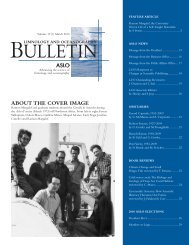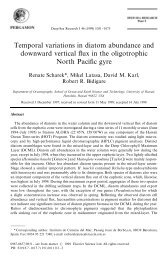REPORT OF THE WORKSHOP ON TRAWL SURVEY ... - FAO.org
REPORT OF THE WORKSHOP ON TRAWL SURVEY ... - FAO.org
REPORT OF THE WORKSHOP ON TRAWL SURVEY ... - FAO.org
You also want an ePaper? Increase the reach of your titles
YUMPU automatically turns print PDFs into web optimized ePapers that Google loves.
estimates against abundance indices. In 2000, all the commercial CPUE series except one<br />
were removed from the assessment due to concerns over the reliability of the data, and since<br />
2001, the assessment has used only the IBTS or component national groundfish surveys.<br />
The most recent reports of the major ICES stock assessment working groups, covering the<br />
North Sea, Baltic, Barents Sea, Iceland, Faroes, Greenland, Northern Shelf and Southern<br />
Shelf, indicate that 55 or more different research surveys are currently used for tuning the<br />
assessments. These are predominantly bottom trawl surveys but also include beam trawl,<br />
acoustic, egg, larval and pre-recruit surveys, and one fixed-net survey.<br />
Out of 72 fish stocks with an assessment of stock trends given by ACFM in 2006, 39 of the<br />
assessments were tuned or carried out using only survey data, 5 used commercial CPUE data<br />
only, and 28 used a mixture of both. Many deep-water and elasmobranch stocks are data-poor<br />
and do not have analytical assessments. Survey data are sparse for the deepwater stocks and<br />
the larger elasmobranch species.<br />
Where fishery and survey CPUE are used together for tuning an age-based assessment, it is<br />
often the case that the surveys carry most weight at the youngest age classes, whilst<br />
commercial fishery CPUE fits the VPA population trends better at the older age classes. This<br />
is partly due to noisier survey data for older age classes where survey catch rates are very low,<br />
but also due to correlations arising from fishery CPUE fleets that contribute substantially to<br />
the catch at age matrix and may also suffer the same problems of misreporting etc.<br />
Surveys used by ICES Working Groups<br />
ICES places great emphasis on the international coordination of surveys. Areas such as the<br />
North Sea and Western Waters are very large, and it is expensive for a single country to<br />
achieve full spatial coverage with the desired sampling intensity. Involvement of several<br />
countries spreads the costs, brings a wider range of expertise to bear, but also brings issues of<br />
standardisation, inter-calibration of vessels and gears, data exchange, quality control and data<br />
management.<br />
The most extensive surveys used by ICES are the International Bottom Trawl Surveys<br />
(IBTS). The North Sea IBTS started off in 1961 as a herring survey, then its use extended to<br />
demersal stocks in the 1970s with an associated expansion of range. The surveys became<br />
internationally coordinated through ICES in 1965. Initially a single quarter-1 survey, the<br />
IBTS increased to four quarterly surveys per year in 1991-96, but was subsequently reduced<br />
to Q1&Q3 only. Figure 1 shows how the trawl stations for the North Sea IBTS are allocated<br />
between countries. Since 1994, the IBTS WG has also assumed responsibility for<br />
coordinating surveys in western and southern waters (Fig. 2). The history of the IBTS is given<br />
in more detail in the IBTS manual (IBTSWG 2006).<br />
The ICES coordinated surveys usually started off with national surveys using quite different<br />
fishing gears and methods. Over time these have become more standardised, and all North<br />
Sea surveys within IBTS now use the GOV (Grande Overture Verticale) trawl, a highheadline<br />
(4-5m) otter trawl. The western and southern surveys use a greater variety of gear<br />
variants and survey designs, although participating countries have where possible adopted a<br />
version of the GOV trawl. There has however been much discussion within IBTS to develop a<br />
new “standard” trawl more suitable for the wide variety of fishing conditions encountered.<br />
Other major international survey programmes within ICES include the Baltic International<br />
Trawl Surveys (WGBIFS, 2006 and earlier) and the Barents Sea trawl surveys. A series of<br />
beam-trawl surveys in the North Sea and western waters is coordinated by the ICES<br />
43




